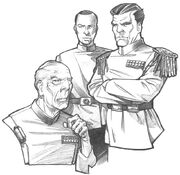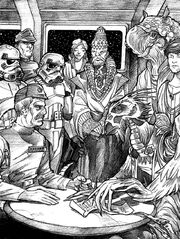
Star Wars Outlaws has released and spoilers from it will begin to appear on the wiki per our Spoilers policy. If making any edits concerning the game please be sure to add Template:Spoiler to the top of the page to warn others.
Don't have an account? Advertisement
Everything I tell you is a lie.
Parts of this article are self-contradictory or confusing and need to be edited for clarity.
Please see the relevant discussion on this article's talk page, consult relevant sources, and fix the article however you can. This notice may be removed once the internal logic of the article has been improved.

| New Republic [1] | Imperial Remnant [1] |
| Chief of State Ponc Gavrisom [1] | Supreme Commander Gilad Pellaeon [1] |
"After more than two decades, the galaxy's most devastating war ended with the muted scratch of a writing stylus." ―Voren Na'al [4]
The Pellaeon–Gavrisom Treaty was a historic peace treaty that marked the official end of the Galactic Civil War, a low-intensity conflict between the Imperial Remnant and the New Republic that had been a major galactic war between the Alliance to Restore the Republic and Galactic Empire prior to its collapse. The treaty of peace was signed by the Imperial Remnant's Supreme Commander, Fleet Admiral Gilad Pellaeon, and the New Republic's Chief of State Ponc Gavrisom, in 19 ABY.
While various elements sought to restore the Empire, including the campaigns of Grand Admiral Thrawn and the reborn Emperor Palpatine, Admiral Natasi Daala, with the last attempt conducted by Pellaeon and his Imperial Remnant. However, all these efforts ultimately ended in failure, with remaining Imperial forces driven back to the the Outer Rim,
The Imperial Remnant after five relatively peaceful years, began to suggest the cessation of hostilities, resulting in it suing for peace for the New Republic and opened it to trade and commerce and putting forth limitations on smuggling, while permitting systems in each side to choose their alignment.
In the years following the Battle of Endor, Galactic Empire and New Republic forces engaged in several temporary, localized alliances against mutual threats. 4 ABY saw the Bakura Truce against the Ssi-ruuk [6] and the Battle of Saijo against the Tofs, [7] and 7 ABY saw the Battle of Vahaba against the forces of Zsinj. [8]
The first tentative plan for comprehensive peace between the New Republic and Imperial Remnant was proposed by Imperial Admiral Betl Oxtroe to the New Republic Provisional Council in 7 ABY. Oxtroe's proposal would appoint Emperor Palpatine's 11-year old grand-niece Ederlathh Pallopides as the titular Empress, with the former New Republic councilors holding effective power. Although the New Republic was eager to negotiate, the secret talks soon ended when Oxtroe was assassinated, apparently by Noghri under the direction of Grand Admiral Thrawn. [9]
A truce between the Imperial Remnant and the New Republic was also proposed to Pellaeon in 13 ABY by Baron Ragez D'Asta and his daughter, Feena D'Asta, as the cost of their bringing the D'Astan sector back into the Empire. [5] Pellaeon dispatched Feena D'Asta and Zam Basdor to negotiate with Mirith Sinn and Kir Kanos of the New Republic, but the meeting was disrupted by the Restored Empire faction who succeeded in killing D'Asta. [10]
"It's time to send an emissary to the New Republic. To discuss the terms of our surrender." ―Fleet Admiral Gilad Pellaeon to Captain Ardiff [11]
In 17 ABY, after five relatively peaceful years, Imperial systems near the Hydian Way began to suggest the cessation of hostilities. The New Republic Senate was favorable and proposed an amnesty for former Imperials within the Republic as a peace overture. Fearing an invasion, the Council of Moffs secretly contacted Admiral Natasi Daala, who had unified the replacement warlords, and proposed a campaign against the New Republic. The campaign was disastrous for the Imperial Military and the Imperial Space was reduced to eight remote sectors in the Outer Rim. [12] [3]

The final treaty was the brainchild of Pellaeon who, after acknowledging the impossibility of an honorable victory over the New Republic, proposed it to the Council of Moffs, select officers of the Imperial Starfleet, and other officials who, for the most part, grudgingly agreed. [3] Moff of the Braxant sector's Vilim Disra, though openly siding with Pellaeon, chose to side with Imperial Guardsman Grodin Tierce and a con-artist named Flim to take advantage of the Caamas Document Crisis in order to nearly bring both the Republic and the Empire into separate internal civil wars. [11]
Pellaeon and Leia Organa Solo engaged in preliminary talks aboard the Millennium Falcon in the Pesitiin system before Pellaeon returned to Bastion. Fifteen days after Disra was detained by Pellaeon at Bastion, Gavrisom and Pellaeon signed the treaty aboard the Imperial I-class Star Destroyer Chimaera. [1]

The treaty put an end to the Galactic Civil War and opened the Imperial Remnant to trade and commerce with the New Republic. Additionally, it put forth limitations on smuggling for both governments to enforce. In addition, systems in either faction would be allowed to choose their alignment. [1] The treaty also banned the use of cloaking devices. [3]